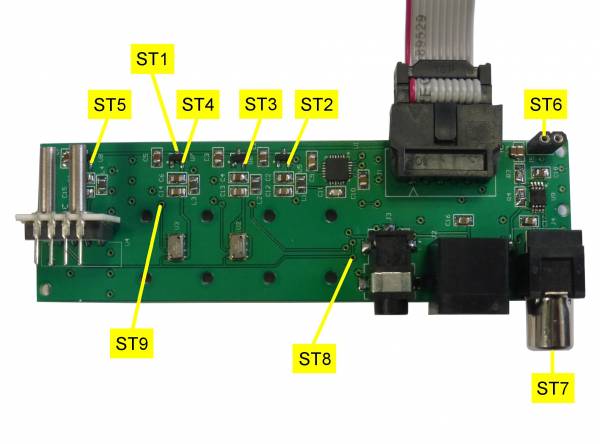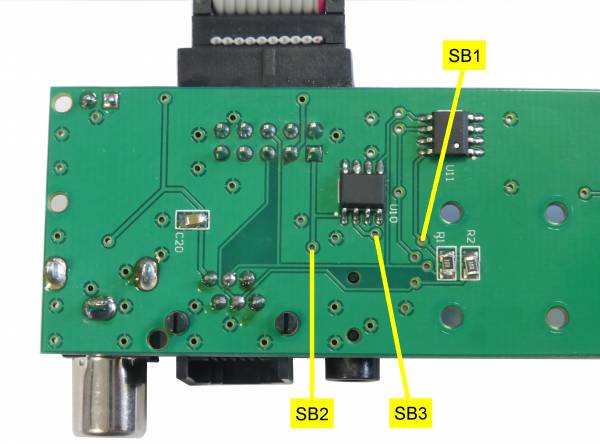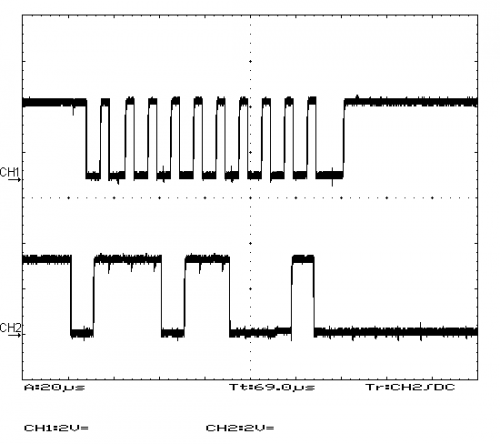Table of Contents
Sensorboard
Testing of the sensorboard requires, that all other PCB's are working properly. The 10-pin ribbon cable must be connected to the Adapterboard and the single Audio cable to J5 must be connected to the Cubieboard Headphone Connector (GND comes via the ribbon cable). It is recommended to perform the electrical tests before sealing the POM-block. A loudspeaker is connected via a CINCH cable to J4. Take care that the outer conductor of the CINCH-connector is isolated from the metal housing, otherwise the audio amplifier for the Vario does not work properly. The Audio Synthesis is made on the Cubieboard using ALSA (Advanced Linux Sound Architecture). The Volume can be controlled with alsamixer from the shell. Persistent storage of the alsamixer-settings can be made with alsactl store. Here are more details about the Audio Vario. Some components (MS5611, MPU-9150) do not offer direct access to their terminals, therefore the testpoints can be located more far away as expected.
Test Points Sensorboard (Connected to Adapterboard via 10-pin ribbon cable and to Cubieboard earphone via single wire)
Testpoints Sensorboard Top
| Test Point | Description | Nominal Value | Measured | Remarks |
|---|---|---|---|---|
| SB1 | 3.3 VCC EEPROM | 3.3 V | Supply for Serial EEPROM U11, Pin 8 | |
| SB2 | 3.3 VCC SNGLWRBM | 3.3 V | Supply for the Single Wire Bus Master U10, Pin 1 | |
| SB3 | SNGLWRBM IO | IO | IO of the Single Wire Bus Master U10, Pin 2 to be measured only on malfunction of external temperature sensor |
Testpoints Sensorboard Bottom
Links to Datasheets
Sensorboard Schematics and Board
AS1360 Voltage Regulator (obsolete)
Drop-in Replacement for AS1360: MCP1700
MPU-9150 Motion Processing Unit
AMS5915 Differential Pressure Sensor
Testing the I2C-Devices
Tests of the I2C-Bus devices are made with i2cdetect, which can be found at the OpenVario ftp-Server ftp://ftp.openvario.org/images/archive/ filename: CARD_CB2_70LVDS_20140704_0646.img.gz (Size: 1.3 GByte)
Quit XCSoar with “Ctrl C” and use the utility program from the above mentioned image
sudo i2cdetect -y 1
from the command-line the result should look like (except for the comments):
0x18 ...... Single-Channel 1-Wire Master (U10) 0x28 ...... AMS5915 Differential Pressure Sensor for Indicated Airspeed (U4) 0x48 ...... ADS 1110 Analog to Digital Converter for Battery Voltage (IC4 on Adapterboard) 0x50...0x57 Serial EEPROM (U11) 0x68 ...... MPU-9150 Motion Processing Unit (U1 Gyro Accelerometer Magnetometer) 0x76 ...... MS5611 Static Pressure Sensor (U2) 0x77 ...... MS5611 TEK-Pressure Sensor (U3)
Screenshot i2cdetect
If one or more devices can not be seen with i2cdetect, reworking is required. The most critical components are MS5611 and MPU-9150, both having their solder pads underneath. If no I2C-device at all can be seen, check the I2C-Signals ST8 and ST9 using an Oscilloscope. The Signal should roughly look like:
I2C-Screenshot Oscilloscope
In the future (since end of 2015) all released images will include i2cdetect by default. If you want to avoid to download an 1.3 Gbyte image, you can use the following instructions to install i2cdetect.
- Connect the Cubieboard with the Internet via Ethernet cable
- Quit XCSoar and Exit to the Shell in the OV-menu
- Type at the command prompt:
opkg update opkg install i2c-tools i2cdetect -y 1
Preparing the I2C Serial EEPROM
The Serial EEPROM (U11) contains correction data for the sensors and other information, e.g. the serial number. Before the EEPROM can be used, it must be initialized. This can be achieved with the Linux program sensorcal using the Option -i
sensorcal -i
After a successful initialisation, the 6-digit serial number of the device can be written using
sensorcal -s xxxxxx
For xxxxxx I used three leading Zeros, my builder-number followed by the letter A for my first sensorboard and followed by the letter B for the second one. At the moment only the offset correction data of the differential pressure sensor is written to the EEPROM. In a future Version the other sensor corrections will also be stored in the EEPROM (for better interchangeability of boards), but at present their data is stored on the SD-card in the file sensord.conf. Have a look at the sensord, a Linux-daemon, which communicates with the SensorBoard.
The Calibration of the Differential Pressure Sensor can be made using the Option -c
sensorcal -c
This automatic Sensor Calibration Routine is accessible from the OV-Menu
Back to Electrical Tests
Back to OpenVario Hardware Architecture





